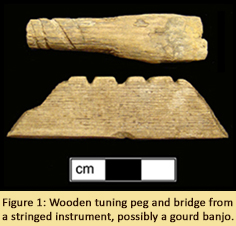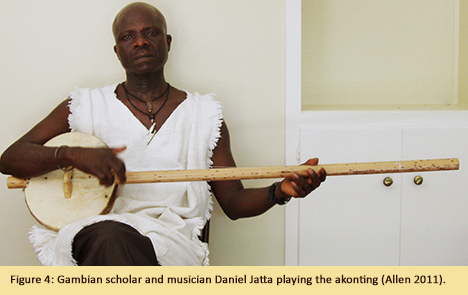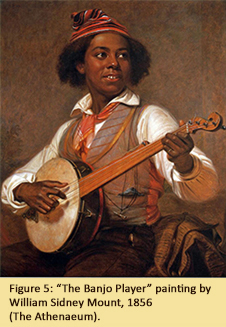Curator's Choice 2015
The instrument proper to them is the Banjar, which they brought hither from Africa
Evidence of an African Instrument in Colonial Maryland?
February 2015
By Rebecca Morehouse, MAC Lab State Curator
 In 1985, during excavations at the Addison Plantation site in Prince George’s County, Maryland, archaeologists excavated a well, which had been used as a refuse dump during the better part of the 18th century (Garrow 1986: 375). The waterlogged nature of the lowest section of the well, which dated to the second quarter of the 18th century, led to the preservation of hundreds of fragments of wood. Among these wood fragments were a bridge and tuning peg from a stringed instrument (Figure 1).
In 1985, during excavations at the Addison Plantation site in Prince George’s County, Maryland, archaeologists excavated a well, which had been used as a refuse dump during the better part of the 18th century (Garrow 1986: 375). The waterlogged nature of the lowest section of the well, which dated to the second quarter of the 18th century, led to the preservation of hundreds of fragments of wood. Among these wood fragments were a bridge and tuning peg from a stringed instrument (Figure 1).
The bridge appears to be hand carved with irregularly spaced notches of varying depths. The bridge has four clear notches for strings with a possible fifth notch barely visible where a section of the bridge has broken off (see the left side of the bridge in Figure 1). The tuning peg also appears to be hand carved and has a groove in which to run a string. Since these two objects were found within the same level of the well, an assumption has been made that they are from the same instrument.
 While correctly identified as parts of a musical instrument almost three decades ago, these objects had received little additional attention until February 2014, when researcher and musician, John O’Loughlin, examined them. Mr. O’Loughlin noted their “homemade” appearance and suggested they could be from a type of instrument known to have been made and played by enslaved individuals from the 17th century onward. He described this instrument as a gourd with vellum skin and a wooden neck, four or five strings, somewhere between the West African instrument called an akonting and the later banjo (personal communication, February 11, 2014). The earliest known depiction of this type of instrument in America can be found in the watercolor painting “The Old Plantation” which is curated at the Abby Aldrich Rockefeller Folk Art Museum in Williamsburg, Virginia (Figure 2).
While correctly identified as parts of a musical instrument almost three decades ago, these objects had received little additional attention until February 2014, when researcher and musician, John O’Loughlin, examined them. Mr. O’Loughlin noted their “homemade” appearance and suggested they could be from a type of instrument known to have been made and played by enslaved individuals from the 17th century onward. He described this instrument as a gourd with vellum skin and a wooden neck, four or five strings, somewhere between the West African instrument called an akonting and the later banjo (personal communication, February 11, 2014). The earliest known depiction of this type of instrument in America can be found in the watercolor painting “The Old Plantation” which is curated at the Abby Aldrich Rockefeller Folk Art Museum in Williamsburg, Virginia (Figure 2).

 It is well documented that the instrument that we know today as the banjo evolved from very similar instruments played by the enslaved peoples who were brought to America from West Africa (Gibson 2001). For decades, researchers and musicologists looked to lutes, such as the ngoni, as the most likely predecessor to the modern day banjo. The ngoni has an oblong wooden or gourd body with an animal hide covering and a flat,”unfooted” bridge that either rests directly on the hide itself or is inserted into a hole in the hide covering (Figure 3). In more recent years, research conducted by scholars and musicians, Daniel Jatta, Ulf Jägfors, and Shlomo Pestcoe, has pointed toward the akonting as the more likely archetype of the early banjos (Pestcoe n.d.). With its round, hollow gourd body and “footed” bridge, the akonting looks more like a modern day banjo than the ngoni Figure 4). Additionally, the akonting is played in an almost identical style to the 19th century banjos (Figure 5) (Allen 2011).
It is well documented that the instrument that we know today as the banjo evolved from very similar instruments played by the enslaved peoples who were brought to America from West Africa (Gibson 2001). For decades, researchers and musicologists looked to lutes, such as the ngoni, as the most likely predecessor to the modern day banjo. The ngoni has an oblong wooden or gourd body with an animal hide covering and a flat,”unfooted” bridge that either rests directly on the hide itself or is inserted into a hole in the hide covering (Figure 3). In more recent years, research conducted by scholars and musicians, Daniel Jatta, Ulf Jägfors, and Shlomo Pestcoe, has pointed toward the akonting as the more likely archetype of the early banjos (Pestcoe n.d.). With its round, hollow gourd body and “footed” bridge, the akonting looks more like a modern day banjo than the ngoni Figure 4). Additionally, the akonting is played in an almost identical style to the 19th century banjos (Figure 5) (Allen 2011).
 It is possible that the bridge and tuning peg from the Addison Plantation site are from an instrument similar to one of these West African instruments. Greg Adams, ethnomusicologist and banjo player, said that the flat,”unfooted” bridge suggests an instrument more like a West African lute (personal communication, January 14, 2015). However, Pete Ross, banjo player and builder, stated that, while not common, it is possible for a banjo to have this style bridge (personal communication, January 14, 2015). Neither the ngoni nor the akonting have tuning pegs; however, we know that by the late 18th century, some of the stringed gourd instruments being played by enslaved people in America had tuning pegs, as evidenced by the painting “The Old Plantation” (Figure 2).
It is possible that the bridge and tuning peg from the Addison Plantation site are from an instrument similar to one of these West African instruments. Greg Adams, ethnomusicologist and banjo player, said that the flat,”unfooted” bridge suggests an instrument more like a West African lute (personal communication, January 14, 2015). However, Pete Ross, banjo player and builder, stated that, while not common, it is possible for a banjo to have this style bridge (personal communication, January 14, 2015). Neither the ngoni nor the akonting have tuning pegs; however, we know that by the late 18th century, some of the stringed gourd instruments being played by enslaved people in America had tuning pegs, as evidenced by the painting “The Old Plantation” (Figure 2).
It could be argued that these objects suggest an instrument with blended characteristics of both the ngoni and akonting and may represent, as John O’Loughlin speculated, the remains of an instrument that is something between the West African stringed instruments and the modern day banjo. Creativity, ethnic tradition, variation in skill, as well as availability of materials, would likely have influenced the construction and style of the gourd instruments being made and played by enslaved people throughout colonial America. All of which may have played an important role in transforming West African instruments to uniquely African-American ones.
*Note: Quote from Thomas Jefferson’s book Notes on the State of Virginia (Peden 1954: 288).
| References |
|
| Abby Aldrich Rockefeller Folk Art Museum |
| n.d. |
Web resource: http://history.org/history/museums/collections/PaintingsDrawings.cfm accessed January 22, 2015. |
|
| Allen, Greg |
| 2011 |
Banjo Roots, Reconsidered Web resource: http://www.npr.org/2011/08/23/139880625/the-banjos-roots-reconsidered accessed January 21, 2015. |
|
| The Athenaeum |
| n.d. |
Web resource: http://www.the-athenaeum.org/art/detail.php?ID=21919 accessed January 22, 2015. |
|
| Bernunzio Uptown Music |
| n.d. |
African Ngoni. Web resource: http://bernunzio.com/product/african-16394/ accessed January 28, 2015. |
|
| Garrow, Patrick H. and Thomas R. Wheaton, Jr. |
| 1986 |
Oxon Hill Manor Archaeological Site Mitigation Project. Prepared for the Maryland Department of Transportation, State Highway Administration. |
|
| Gibson, George R. |
| 2001 |
Gourd Banjos: From Africa to the Appalachians. Web resource: http://www.banjohistory.com/article/detail/1_gourd_banjos_from_africa_to_the_appalachians accessed January 14, 2015. |
|
| Peden, William, ed. |
| 1954 |
Thomas Jefferson, Notes on the State of Virginia. Chapel Hill: University of North Carolina Press. |
|
| Pestcoe, Shlomo |
| n.d. |
Banjo Ancestors Detectives: Daniel Jatta & Ulf Jägfors. Web resource: http://www.shlomomusic.com/banjoancestors_jatta.htm accessed January 22, 2015. |
|